Treatment of osteochondrosis of the cervical spine using the latest highly effective techniques, with modern equipment and under the guidance of experienced professionals.
Spinal diseases can cause many unpleasant sensations in a person, especially if they affect the neck region: there is a risk of damage to the spinal cord and brain. In addition, osteochondrosis of the cervical spine often leads to headaches, disorders of the internal organs, and contributes to the deterioration of blood circulation. Fortunately, today, a number of therapeutic techniques have been developed that make it possible to eliminate unpleasant symptoms and restore the health of the spine.
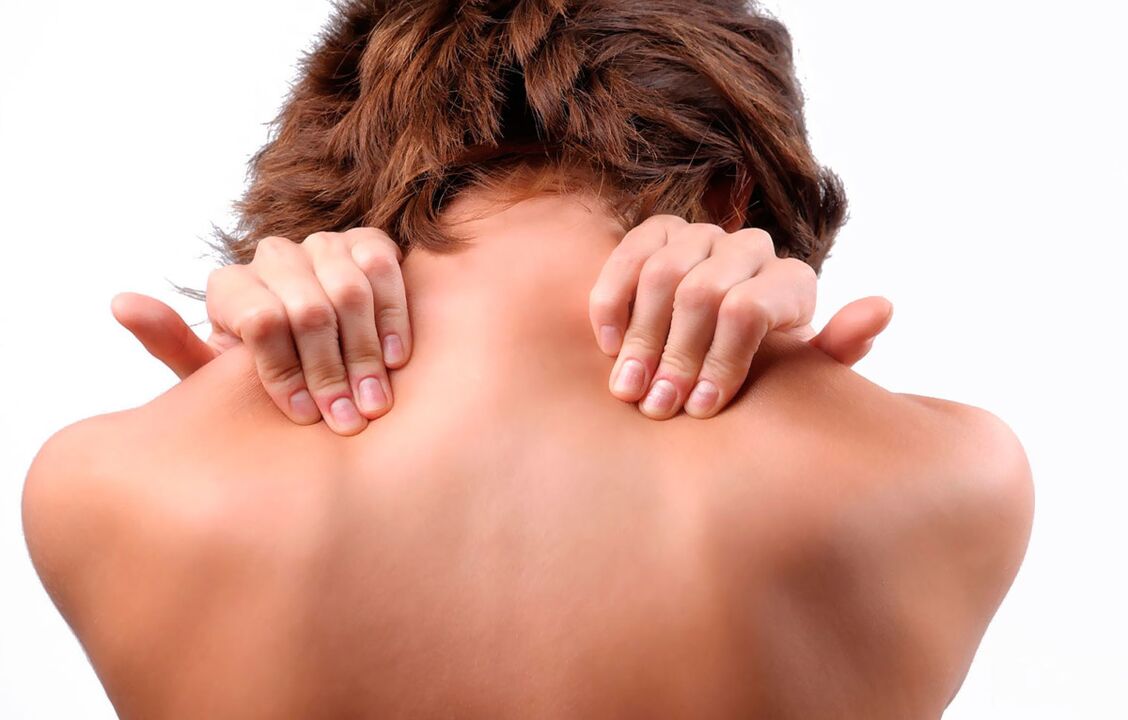
In this article, we describe in detail the characteristics of cervical osteochondrosis and describe the main methods of treatment. We hope that after reading this you will be able to choose the most effective method to treat this disease and be able to avoid radical surgeries.
What is cervical osteochondrosis?

Cervical osteochondrosis is a disease in which the soft pulp becomes ossified, which serves as a calming function between the vertebrae. At the same time, blood vessels and nerve roots are involved in the mechanism of disease development.
Osteochondrosis of the cervical spine is characterized by pain in the shoulder, occiput, neck, and head. In addition, patients note the onset of dizziness, increased blood pressure, oxygen starvation, loss of sensitivity on one side of the tongue, and other symptoms characteristic of cardiovascular pathologies. This will be the reason to contact a doctor in other specialties and will significantly slow down the process of diagnosing the disease.
Most commonly, middle and older age groups tend to ossify the tissues of the upper part of the spine. This is due to the incorrect distribution of the dynamic and static load on the human skeleton.
However, if you have a history of cervical osteochondrosis and itssymptomsIt has been diagnosed in people older than 45-50 years, but the age of patients with this disease is significantly younger. Today, it affects young people between the ages of 20 and 40, leading to a deterioration in diet and physical inactivity.
Currently, a dual approach to the cervical spine problem is used: it is considered a combination of physiological and pathological factors. In the first case we are talking about the aging of the body due to unavoidable natural phenomena, in the second we assume that the destruction of intervertebral formations occurs in the background of inflammatory and dystrophic processes caused by improper lifestyle.
Symptoms of osteochondrosis of the cervical spine
Problems in diagnosing this disease are caused by a lack of pain in certain situations and the implicit nature of the symptoms. In addition, a person may not feel signs of illness while regularly taking strong painkillers to minimize overall discomfort. All this can lead to serious disorders in the area of the neck joints.
Among the obvious symptoms of cervical osteochondrosis that make it necessarytreatment,the following: headache, high blood pressure, frequent dizziness. We'll talk about them further.
Dizziness with cervical osteochondrosis

Dizziness does not always manifest itself in the background of cervical spine problems. In some cases, it indicates brain disorders, vascular and cardiac dysfunction, inflammatory processes in the ear and nose, malignancies, or any pathological condition of the nervous system.
The dizziness associated with cervical osteochondrosis and the need to treat it may be non-systemic or systemic etiology.
In the first case, one can state the feeling of stunning, insecurity while standing and half faintly. However, the cycle does not make sense.
As for systemic dizziness, it is most often evidence of vestibular abnormalities, visual analyzer malfunction, and other changes in the background of osteochondrosis. In this case, the patient may feel the rotation of the body or nearby objects.
If dizziness occurs and the patient develops concomitant symptoms such as acute headache, numbness in the upper chest, fainting, or impaired coordination of movements, should be hospitalized immediately.
Headache with osteochondrosis of the cervical spine
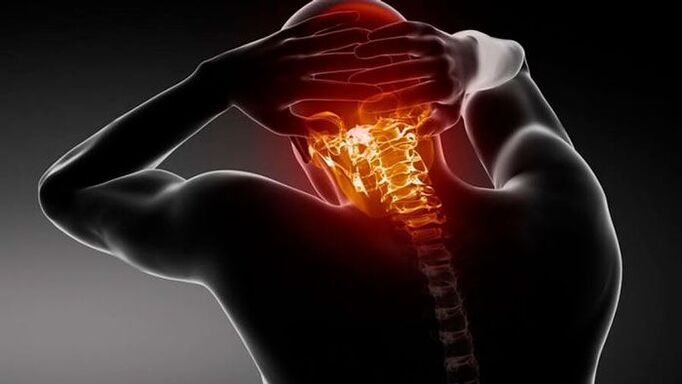
The appearance of a headache can indicate the presence of a variety of diseases. It is most common in women with hormonal disorders, stressful situations, increased intracranial pressure, brain cramps, pinched nerve endings, inflammatory processes, and other diseases.
may indicate the presence of a variety of diseases. It is most common in women with hormonal disorders, stressful situations, increased intracranial pressure, brain cramps, pinched nerve endings, inflammatory processes, and other diseases.
Pain andnoise in the headwith osteochondrosis of the cervix, which necessitates treatment, is often confused with symptoms of acute cerebral blood supply, arterial hypertension, or coronary artery disease. Such signs are most common in older people with the above diseases.
Consult an experienced professional to determine the exact cause of the headache. In this case, it is recommended to have an ECG and rule out cardiovascular disorders.
Other localization pain characteristic of cervical osteochondrosis
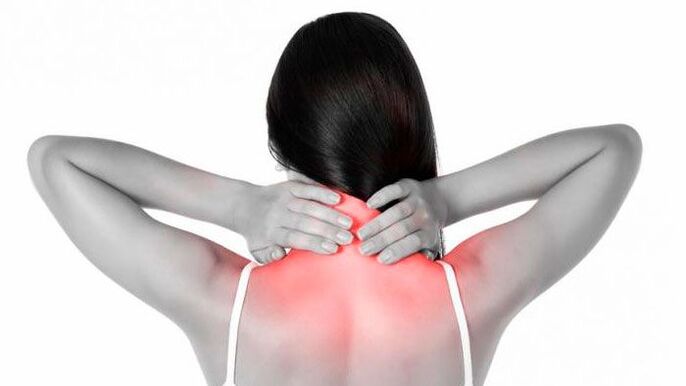
Pain in the head and back of the head is not always a sign of cervical osteochondrosis. In some cases, discomfort can range from the neck to the arms and shoulders. Such symptoms are sudden in nature and may occur in the background of sudden movements, after a sharp sneeze, or may remain in one position during sleep at night.
If the cause of the pain syndrome is chondrosis of the cervical spine, it usually disappears after a certain time, or disappears after manual therapy on the cervical spine.
It should be noted that massage in this area is performed only after a thorough examination of the patient. With a non-professional approach, there is a high risk of the patient's condition deteriorating or even being disabled.
When talking about osteochondrosis of the cervical spine and the need to treat it, patients notice the following feelings of pain:
- The appearance of a crackle as the head rotates;
- The presence of pain syndrome within the neck;
- Deterioration of sensitivity and the appearance of muscle weakness in different areas of the body.
Increased blood pressure with cervical spine problems

Because the cervical vertebrae are directly connected to blood vessels and nerve endings, any abnormality in this area can increase the rise in blood pressure. However, such jumps are temporary in nature, present as short-term seizures, and are not symptoms of high blood pressure.
Furthermore, if you suffer from osteochondrosis of the cervical spine, in addition to the increase in pressure, the patient may experience other symptoms, and treatment in this case includes the use of special anesthetic drugs. These include:
- Appearance of pain in the head area;
- Loss of sensitivity in the collar;
- Pain in chest, arms and legs;
- Sudden increase in blood pressure after stressful situations, prolonged stay in one position, excessive muscle tension, and other similar situations.
A sharp deterioration in the patient's condition and a sharp increase in pressure indicate the need to see a doctor urgently.
Stages of development of cervical osteochondrosis
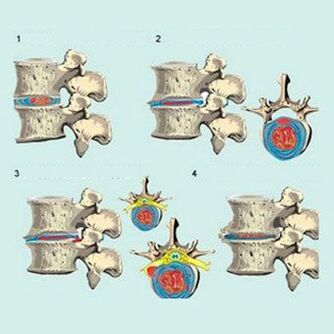
With its development, the above disease goes through several stages, accompanied by special symptoms. We discuss them in more detail below.
Initial stage osteochondrosis
As a general rule, if grade 1 disease occurs, patients may experience only minor discomfort. They can only show pain with sudden movements, tilting and rotating the head. Many patients report increased fatigue and constant tension in the lumbar spine and back. Treatment of osteochondrosis of the cervical spine in the initial stage does not involve takingmedicines. . . To recover, the patient only needs to performgymnasticscervical osteochondrosis and change your daily diet.
Second stage of the disease: characteristics
The second stage of the pathology is characterized by more intense pain sensations that radiate to the upper extremities and increase with bending and rotation of the head. The reasons for the increased discomfort are to reduce the height of the intervertebral discs and, as a result, to tighten the nerve endings. In this case, the patient notes a deterioration in work capacity, the appearance of absence, increased fatigue, and the occurrence of headaches.
Third degree osteochondrosis
Increased pain is accompanied by irradiation of the upper limbs as well as the shoulder and neck area. In this case, numbness of the muscles of the hand is observed, which is accompanied by the appearance of an intervertebral hernia. In addition, patients may complain of severe weakness and dizziness.
The last stage of the disease

In the final stage, deep degenerative processes in the area of intervertebral discs and their replacement by abnormal tissues are felt. The need for treatment of cervical osteochondrosisin the exacerbation stagemay be due to the defeat of several segments of the spine. In this case, patients report tinnitus, increased pain syndrome, severe dizziness, and impaired coordination of movements.
Causes of cervical osteochondrosis
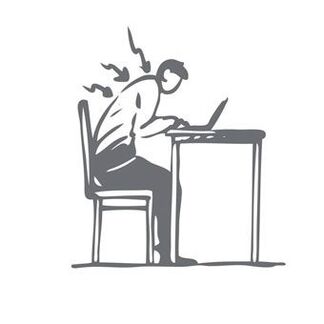
Most often, the development of this pathology is due to daily sitting work, during which a person does not check the correct position of the body in the chair and his head is constantly tilted forward. The same can be said of the length of the head in a protracted, thrown-back condition, which is a typical repair activity for employees of construction specialties.
As a general rule, excessive stress on the cervical spine inevitably leads to degenerative disorders in the vertebral discs. In addition, cervico-vertebral osteochondrosis, the symptoms of this disease, and the need for treatment are due to the following factors:
- Violation of calcium metabolism;
- Genetic causes;
- Heat irritants;
- In the practice of extreme sports (treatment of sports injuries);
- Hypodynamics;
- A person’s long stay in a position because of his or her professional affiliation;
- Obesity;
- Prolonged stressful situations;
- Injury to neck and headrest;
- Autoimmune processes that can trigger cartilage tissue destruction.
Switching to a healthy diet and moderate physical activity can minimize the likelihood of developing osteochondrosis.
Syndromes in cervical osteochondrosis
The syndromes are represented by the simultaneous manifestation of several symptoms of the disease. As for osteochondrosis of the cervical spine, it is characterized by the following syndromes: vertebrae, vertebral arteries, heart and radical. They are discussed below.
What is vertebral syndrome?
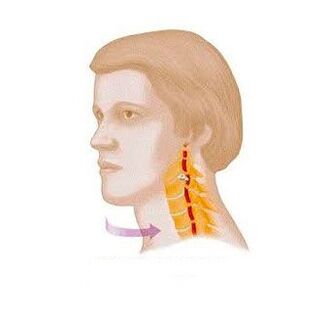
In the presence of the above syndrome, degenerative processes directly affect cartilage and bone tissue. In this case, the following three signals appear simultaneously:
- Painful feelings when the neck needs to be turned;
- Inability to rotate the neck;
- The presence of a disorder in the intervertebral region or in the vertebral body that is morphological in nature (an X-ray is taken to determine this symptom).
If the patient is missing at least one of the above signs, there is no point in talking about vertebral syndrome.
Characteristics of vertebral artery syndrome
The essence of the above syndrome is damage to the vertebral arteries that supply blood to the brain. It is characterized by the concomitant manifestation of the following symptoms:
- Against the background of arterial constriction, the patient experienced dizziness, increased blood pressure, tinnitus, nausea, etc.
- Irritation of nerve roots, loss of sensitivity, appearance of "flies" in the eye, acute headache and numbness are observed;
- Lack of oxygen can cause severe pain in the head area, excessive drowsiness, decreased activity, and decreased concentration.
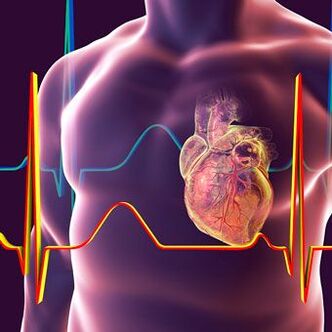
Signs of heart syndrome
In cervical osteochondrosis, in addition to the symptom of the vertebral artery, treatment of the heart is also required in the presence of cardiac syndrome. Many patients report a condition that is characteristic of coronary heart disease or similar to the symptoms of a heart attack. In this case, the following signs occur:
- Burning sensation and acute pain syndrome in the sternum;
- Tachycardia;
- Severe weakness, excessive tiredness and shortness of breath.
Radicular syndrome: characteristics
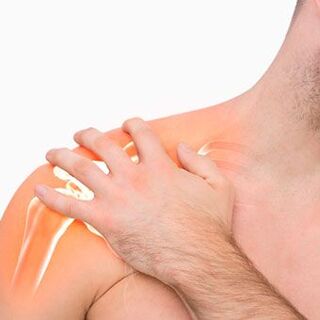
It is characterized by deterioration of neuromuscular conduction. In the presence of radical syndrome, the patient may experience loss of sensitivity or, conversely, severe pain syndrome. Its features are as follows:
- Pain in the back of the head, or vice versa, numbness in this area;
- Difficulty chewing food, numbness in the area behind the ear, feeling of fullness in the tongue;
- Symptoms of sore throat, hiccups, collarbone pain;
- Difficulty moving the upper limbs, discomfort in the shoulder area;
- Violations in the forearm and shoulder blades;
- Loss of sensitivity in the finger area.
Diagnostics
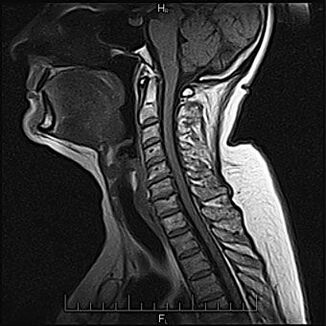
Magnetic resonance imaging (MRI) is one of the main and most informative methods of diagnosing osteochondrosis. MRI scans reflect in great detail not only the condition of the bone tissue in the spine, but also the soft tissue — muscles, cartilage, blood vessels, nerves, and intervertebral discs. If MRI has contraindications (metal prostheses, pacemakers), computed tomography is prescribed, but the information content of the method is much lower for the diagnosis of osteochondrosis.
Is it possible to treat cervical osteochondrosis?
As for cervical osteochondrosis, effective treatment of this disease is only possible through a comprehensive lifestyle review, constant prevention, and restoration of sanatorium. In practice, only a few achieve this, especially in the climate of our country, when it is almost impossible to completely avoid hypothermia and new inflammatory processes. Nevertheless, it can significantly ease your condition, including the most advanced cases, and extend release periods.
Treatment of cervical osteochondrosis

In the first stage of osteochondrosis, the patient is assisted by conservative drug-free treatment. Be in good posture, pay attention to the equipment of the workplace, interrupt work for a few minutes every day to make it easierhealing gymnasticswith osteochondrosis of the cervix, which can be performed directly at the desk in the office. Swimming, increased physical activity, and intake of vitamin and mineral complexes will have a positive effect on the entire musculoskeletal system.
Benefits of Shockwave Therapy
If a patient has osteochondrosis of the cervical spine and its symptoms, a new method of treatment is considered the most effective - using shock waves. This is remarkable because of the affordable cost of the procedure. In addition, if a healthcare institution has special equipment, you can take the UHT course completely free of charge.
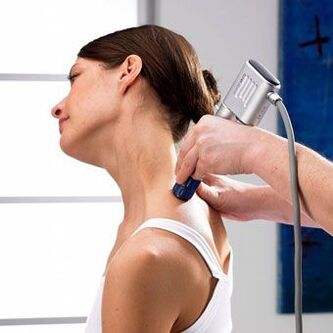
Advantages of UHT:
- Maximum efficiency;
- Absence of inconvenience during the procedure;
- Minimal likelihood of side effects;
- Reducing the need for invasive treatments
- Reducing the need to take medications.
A drug used to treat osteochondrosis of the neck
If you have osteochondrosis of the neck and are interested in treatmentmedicatedandeffective,you can find information on the right medicines on the internet. However, despite the variety of medications and the lack of need for prescriptions, self-medication is not recommended. Most medications have side effects and contraindications, and it is also important not to overdose.
Non-steroidal anti-inflammatory drugs (NSAIDs).They are used to relieve swelling and pain.
Muscle relaxants, sedatives
These are prescribed to relieve the general condition of the patient and to reduce the dose of NSAIDs. You can achieve the best therapeutic effect by simultaneously relieving muscle cramps and nervous tension.
At the end of the course, doctors usually recommend buying non-steroidal anti-inflammatory drugs for the home first aid kit, as neck pain can return due to weather changes, overload, and stress.
Physiotherapy approaches
In cases where drug therapy is contraindicated or does not have the desired effect, and sometimes physiotherapy methods are available that are available in both classical and alternative medicine to achieve a complex effect. Each is designed to relieve muscle cramps, inflammation and pain.
Acupuncture. The essence of the method is to "awaken" the biologically active points by introducing special thin needles to a depth of several centimeters. The procedure itself is painful, but it helps relieve spinal pain. More occupations are needed.

Manual therapy. This method is effective when the patient has itpinchthe nerves of the cervical spine, the corresponding symptoms were diagnosed and the need for treatment was identified. Nerves and blood vessels trapped by deformed vertebrae can be released by manual stretching of the spine.
Hirudotherapy (leeches). Relieves inflammation and swelling due to biologically active substances excreted by leeches. Strengthens blood circulation.
Shockwave therapy. It restores blood circulation and destroys osteophytes, helping to restore the normal structure of cartilage tissue. The patient already feels a reduction in pain and swelling after 1-2 times. The shock wave therapy process includes up to ten procedures, which can be prescribed as part of a complex non-invasive therapy and during the postoperative rehabilitation period. It has a number of contraindications and is used only after extensive examination by several professionals, including a neurologist, cardiologist, and vertebrologist.
Exercises for cervical osteochondrosis
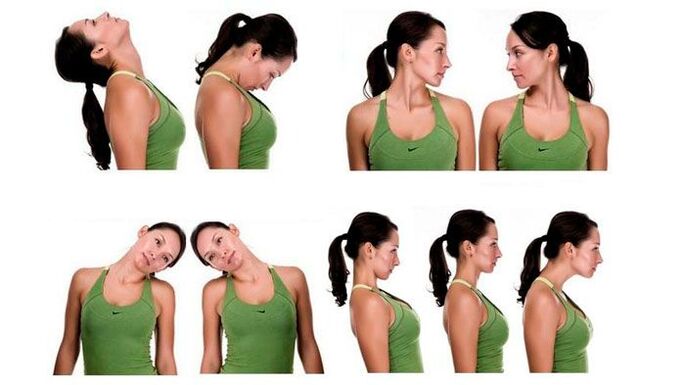
If a person has cervical osteochondrosis, dailytasks,developed for the treatment of this disease, helps to strengthen the muscle corset, which means - to reduce the load on the cervical spine. Exercise is indicated at all stages of the disease as well as as a preventative measure. During exacerbations, a series of exercises should be performed carefully.
Typical exercises for treating cervical osteochondrosis:
- the head turns sideways;
- the head tilts back and forth;
- lift your shoulders with calm or fixed hands, hold them in this position for 15-20 seconds;
- alternating tension of the flexors and stretchers of the neck in the standing position.
The exercises should be repeated 5-7 times. The duration of the hour is 15-20 minutes.
Surgical intervention
In the absence of a positive effect, spinal fusion may be indicated after 6 months of conservative treatment. The purpose of the procedure is to immobilize the affected vertebral segment. This includes removal of the intervertebral disc, decompression of the nerve root, and placement of the implant or creation of the physiological height of the disc space. Surgery has many contraindications and side effects. For example, spinal fusion can lead to vertebral disability. Therefore, surgery is indicated only in extreme cases.
Nutrition and lifestyle
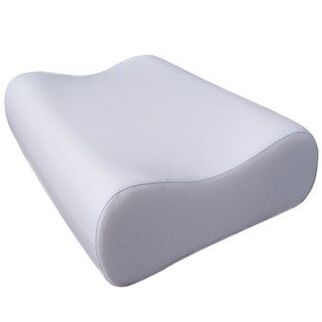
After surgical treatment of cervical osteochondrosis, a fastening collar is required during the early rehabilitation period. During conservative treatment and in the late rehabilitation period, a diet rich in calcium and vitamins, correction of normal postures and posture in general, daily series of neck therapeutic exercises, orthopedic pillows are recommended.
Home treatment of osteochondrosis of the neck
If you are diagnosed with cervical osteochondrosis and its symptoms and want to get throughhome treatment,it should be recalled that such an independent intervention can only be carried out in combination with procedures prescribed by a specialist.
Some experts recommend its useorthopedic pillowcervical osteochondrosis and use warming agents such as pepper plaster, mustard plaster and alcohol compresses. Others say it's just specialtaskstreatment andprevention. . .
You can also use it for recipes from traditional medicine, which are based on honey-potato compresses and topical dressings. More information about such tools can be found on the Internet. However, only an experienced and highly trained physician can diagnose cervicothoracic osteochondrosis, identify its symptoms, and prescribe the most effective treatment.
Preventive measures against cervical osteochondrosis

An examination by your doctor is required once a year. Shockwave therapy can be prescribed. Hypothermia and infectious diseases, prolonged work at the computer in one situation should be avoided. If you are traveling on a long plane or bus, use a neck pillow to relieve muscle tension and prevent congestion. For everyday sleep, use special orthopedic pillows that ensure the correct position of the head.

















































